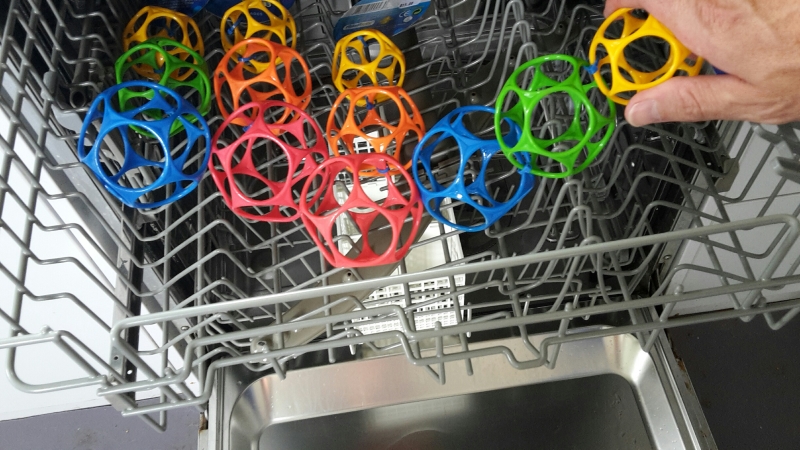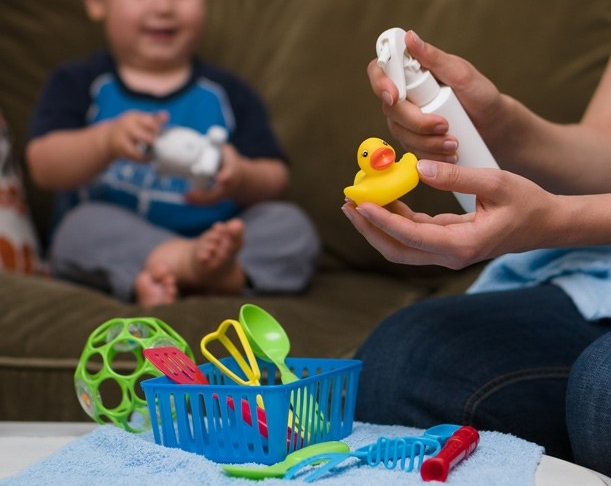Your shopping cart is empty!
If you start thinking about the number of germs that could be lurking about on your kid's toys, you will be furiously scrubbing in no time! From mud and grime, to toilet seat goodness-knows-what and everything in between, your kid’s hands have it all. And a lot of that muck inevitably ends up on their toys. So, it’s really important to know how to clean toys properly.
You know you are going to be doing a lot of wiping, cleaning and washing, so why not make the job easier on yourself? Choose toys that are easy to clean - ones that can easily be wiped, ones without nooks and crannies, ones that can easily be thrown in the washing machine or dishwasher and ones without electronics. All your grand plans of scrubbing and washing can be thwarted by musical boxes, electronic components and battery power!
Check the labels for care instructions when you buy them. It might just influence your decision to purchase one way or the other.
Top Tip: When buying comforter toys … buy two (or more). That way if one is in the wash, you still have a back up!
Without Batteries
It might seem like a disaster if your daughter’s favourite teddy takes a dive into a helping of tomato sauce. But it's not actually the end of the world. Most plush toys can go into the washing machine on the delicate cycle to help remove the muck.
We would also recommend putting the toy in a mesh wash bag to keep it from getting beaten up, or getting caught on anything in the washing machine. If you don’t have a wash bag, then a pillowslip works just as well.
Don't machine wash anything that has…
Other than that, most plush toys are fine in the washing machine. Try to use a front loader if you can as their cycle is more gentle. The mechanism in a top loader can bunch the toy up, or cause it to get caught.
Things to Consider:
With Batteries
If you have plush toys that can't go in the machine, then wipe them down with a damp cloth. If you need more of an intense clean, then use a mixture of vinegar and bicarb of soda to dampen your cloth before cleaning and thoroughly drying.
Without Batteries
Hard plastic toys can actually go in the top rack of the dishwasher on a gentle cycle. Put them in a mesh bag and lie them across the top rack. Make sure you don’t put any dirty dishes in with them though!

If you don’t have a dishwasher, then you can just fill the sink with hot, soapy water. Immerse the toys in the water (as long as they don’t have batteries in them) and leave them to soak for an hour or so. You can scrub the little nooks and crannies with an old toothbrush, and then leave them on the dish rack to dry completely.
If you want a simple way to disinfect your plastic or rubber toys, you can use a solution of 1 cup vinegar to 10 cups of water. Do not use bleach or harsh chemicals when cleaning your children’s toys as they often put them in their mouths. You don’t want traces of bleach or chemicals ending up in their mouths too.
With Batteries
Obviously, you can’t immerse anything with batteries in water, so you will need to sponge them down with a damp cloth dipped in warm, soapy water. Avoid the battery compartment while wiping. You can also wipe the vinegar solution over them too. Dry them with a teatowel first, then put them in the sun to finish them off.
You can use the same method for electronic toys too. Just make sure they are unplugged, and avoid the wiring areas when cleaning.
While made of rubber, bath toys deserve a special mention as they are prone to slime and mould. As mould can be hard to remove, proper care can help prevent it from forming. Drain them well after every use and hang them in a mesh bag. It is important to clean them regularly as well to prevent build up.
When cleaning the outside, this natural cleaning solution [http://www.wikihow.com/Clean-Children%27s-Bath-Toys] is great to use. Leave the toys to soak in it for an hour or so. Then, rinse the toy and scrub with a toothbrush to get that soap scum away. Once you have removed the stubborn slime, you can use the normal steps for cleaning plastic or rubber toys.

Any doll with hair could benefit from a total wash every now and then. Clean the plastic portion first, and then you can use a mild shampoo for their hair. Kids' shampoos are generally a milder formulation, so ideal for dolls.
You just need a small drop, so wet the hair and then massage the shampoo through. Rinse it out and then repeat the same step with conditioner. While the conditioner is in, comb the doll’s hair to remove any knots. Lay the doll flat and fan out her hair to dry.
Again you will want to use a damp cloth to wipe down wooden toys. Careful not to use too much moisture, as wood can warp when it gets wet. Most of the paint used on wooden toys is water-based, for safety, so using too much water when cleaning can damage the paint work.
Because dress-ups are usually made of super delicate fabrics and have lots of beads and embellishments, it is best to handwash them with a delicate wool wash. Don’t use a brush or sponge to scrub them, rather use the dress’ own fabric to rub together.
Try not to wring them out. Instead, hang them on the line to drip dry. Straighten out any of the tulle, or delicate sections so that they dry straight and not all bunched up. No one wants to have to iron if they don’t have to!
These are probably the most important toys to keep clean as they are constantly in your baby’s mouth. Run them through the dishwasher on a regular basis, or sterilise them by placing them in a glass of boiling water.
So there you go, your guide to removing all the grime for the various toys in the toybox. Hopefully this description of how to clean toys helps you keep all your toys clean and safe to play with.
Leave a Comment